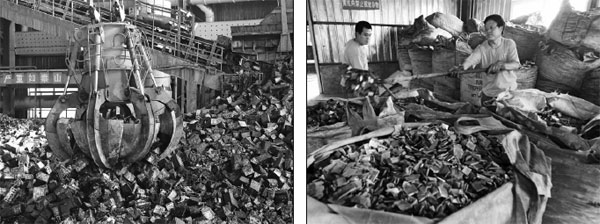GEM sees opportunities in lithium battery reuse, urban mining
|
Workers handle old batteries at a recycling plant in Zouping, Shandong province (right). Used batteries (left) are to be processed at a recycling plant in Jieshou,Anhui province. Provided To China Daily |
GEM Co Ltd, the listed group involved in urban mining - the recycling of metal, old electronics, batteries and catalytic converters that would otherwise be left to decompose in landfill - said it sees great opportunities in lithium battery reuse as China's new energy car sales rapidly expand.
"Although the economy is somewhat cooling down, one thing keeps growing - waste," said Xu Kaihua, chairman of GEM.
Xu said China has around 6 million metric tons of electronic waste. Every year, the country generates 24 billion waste batteries.
"The waste is an urban mine to be exploited and an environmental disaster at the same time," he said.
Founded in 2001, the company, based in Shenzhen, Guangdong province, went public in 2010 on the Shenzhen Stock Exchange. It now has net assets of 6.7 billion yuan ($964 million).
In 2003, GEM proposed the idea of "digging into the urban mines" to recycle used battery, electronic waste, scrap cars and metals containing rare metals such as nickel, tungsten and cobalt.
Battery recycling is an important part of GEM's business portfolio, which accounted for 25 percent of its total revenue of 3.3 billion yuan, up 45.7 percent from the same period last year, in the first half of this year. The profits from battery recycling totaled 36.6 percent of its total net profits of 172 million yuan for the half, which were up 30 percent from last year.
Lithium battery production is expanding thanks to the fast growth of the new energy vehicle sector. The lithium institute of Shenzhen Gaogong Industry Research Co said that in the third quarter of 2016, national output of lithium battery materials was worth 11 billion yuan.
According to research by Li Junhua, chief researcher at the Shenzhen-based ylz360.com, a website for energy consultancy, sales revenues from recycled metals from lithium batteries - including cobalt, nickel, manganese, iron and aluminum - will increase sharply to 5.2 billion yuan in 2018, 13.6 billion yuan in 2020, and more than 30 billion yuan by 2023.
The new energy vehicle plan projects that by 2020, the annual production capacity of the industry will be 2 million units with sales to date of a cumulative 5 million units.
Xu Shiguo, deputy director of GEM's new energy material research institute, said that the company has formed a recycling network throughout China with 12 waste recycling bases.
Since 2005, GEM has treated 15,000 tons of cobalt, 10,000 tons of nickel and 4,000 tons of manganese in its efforts to build an industrial chain of raw materials recycling.
"Our goal is to build a closed cycle in the industry from materials, batteries, new energy car manufacturing, supply chain finance and power battery recycling," said Xu.
yangziman@chinadaily.com.cn



















